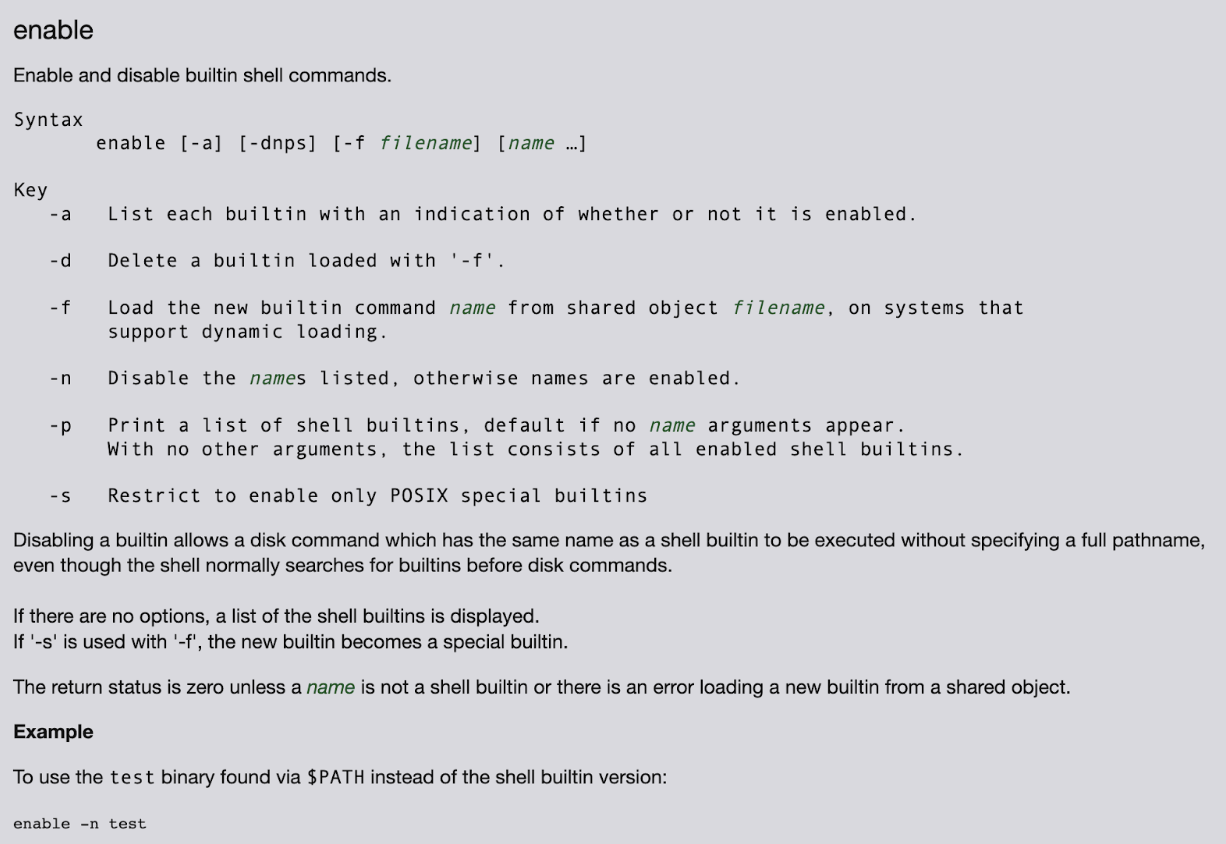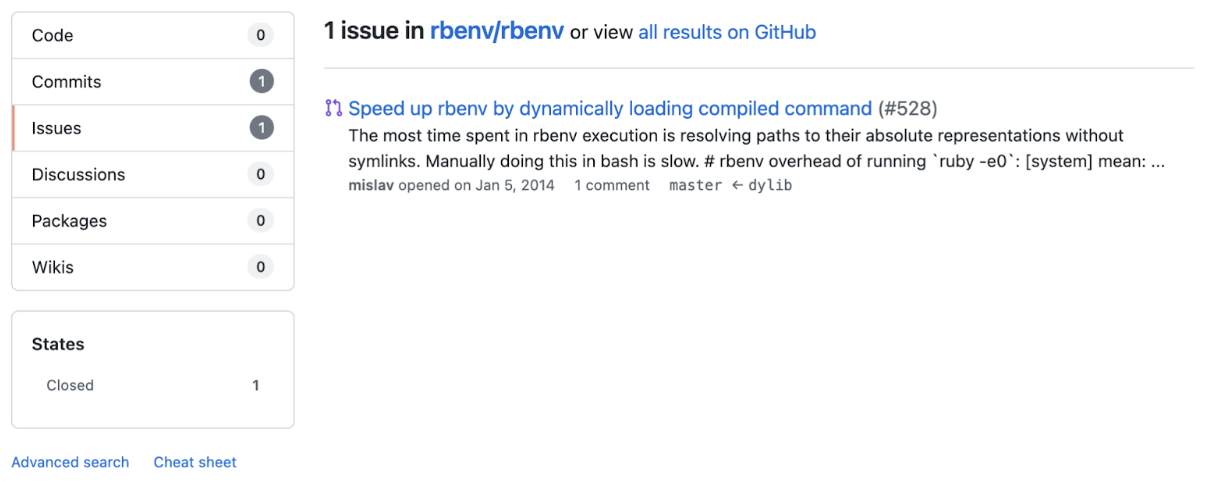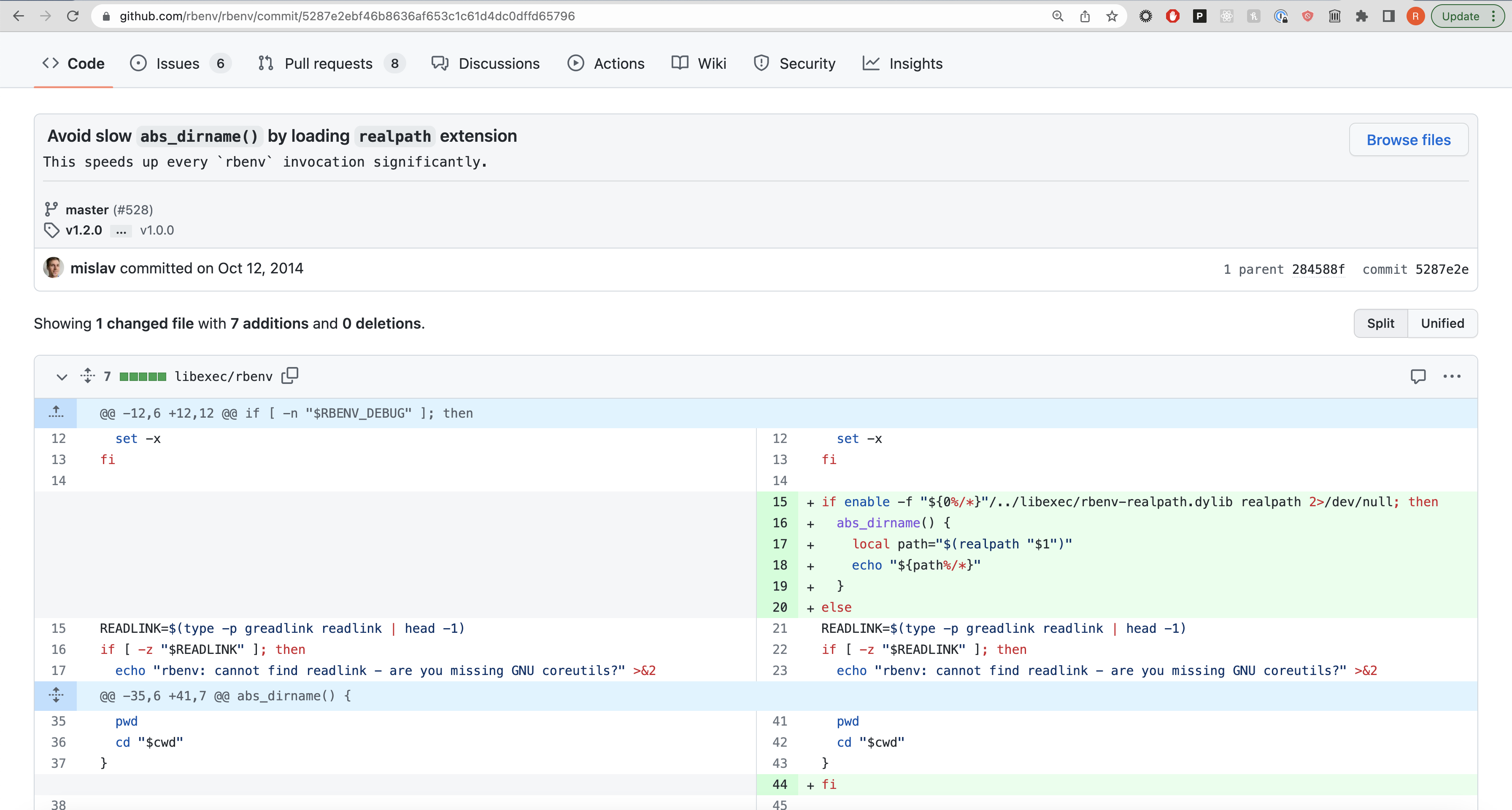if enable -f "${BASH_SOURCE%/*}"/../libexec/rbenv-realpath.dylib realpath 2>/dev/null; then
...
fi
So that I don’t forget, I write down a few questions I have at this point:
- What does the
enablecommand do? - What does its
-fflag mean? - What are the command’s positional arguments?
- What kind of file extension is
.dylib? What does that imply about the contents of the file? - What does
2>/dev/nulldo?
I’ll try to answer these one-by-one.
The enable command
I start by typing both man enable and help enable in my terminal, but each time I see No manual entry for enable.
Luckily, the first result when I Google “enable command bash” looks like a good one, even if it’s not part of the official docs:

This actually answers my first three questions:
- What does the
enablecommand do?- The
enablecommand can take builtin shell commands and turn them on or off. - The link mentions that this could be useful if you have an executable binary which shares the same name as a builtin command, and which is located in one of your
$PATHdirectories. - Normally, the shell would check for builtin commands first, and only search in
PATHif no builtins were found. - You can ensure your shell won’t find any builtin command by disabling the builtin using the
enablecommand.
- The
- What does the
-fflag do?- You would pass this flag if you want to change the source of your new command from its original source (the builtin) to a file whose path you specify after the
-fflag. - In other words, you want to replace the builtin command with your home-made version.
- You would pass this flag if you want to change the source of your new command from its original source (the builtin) to a file whose path you specify after the
- What are the command’s positional arguments?
- In the case of our line of code, the first positional argument is the filepath containing the new version of the command we’re over-riding.
- The 2nd positional argument is the name of the command we’re over-riding.
Note the following:
To use the `test` binary found via $PATH instead of the shell builtin version:
enable -n test
The word “binary” is important here. We can’t just use any old Bash script here- we have to pass a path to an executable binary file, or a file that has been compiled from a human-readable language like C into a different language that is tailored to your machine’s specific CPU type.
I learned this the hard way when I tried to simply write a script and use it to overwrite a known-valid builtin.
Experiment- trying to over-write a builtin with enable -f
I write a simple Bash script called ./foo, which just prints out “Hello world”:
#!/usr/bin/env bash
echo "Hello world"
In my Bash shell, I generate a list of possible builtin commands, using the enable -a command:
bash-3.2$ enable -a
enable .
enable :
enable [
enable alias
enable bg
enable bind
enable break
enable builtin
enable caller
enable cd
enable command
enable compgen
enable complete
enable continue
enable declare
enable dirs
enable disown
enable echo
enable enable
enable eval
enable exec
enable exit
enable export
enable false
enable fc
enable fg
enable getopts
enable hash
enable help
enable history
enable jobs
enable kill
enable let
enable local
enable logout
enable popd
enable printf
enable pushd
enable pwd
enable read
enable readonly
enable return
enable set
enable shift
enable shopt
enable source
enable suspend
enable test
enable times
enable trap
enable true
enable type
enable typeset
enable ulimit
enable umask
enable unalias
enable unset
enable wait
Since I’m familiar with test, I pick that.
I chmod +x the script so that it’s executable, and I try using it to overwrite the test command:
bash-3.2$ chmod + x ./foo
bash-3.2$ enable -f ./foo test
Unfortunately, I get the following error:
bash: enable: cannot open shared object ./foo: dlopen(./foo, 0x0001):
tried: './foo' (relative path not allowed in hardened program),
'/System/Volumes/Preboot/Cryptexes/OS./foo' (no such file), '/usr/lib/./foo'
(no such file, not in dyld cache)
The phrase relative path not allowed in hardened program stands out to me. I try replacing ./foo with $(pwd)/foo:
bash-3.2$ enable -f "$(pwd)/foo" ls
bash: enable: cannot open shared object /Users/myusername/Workspace/OpenSource/impostorsguides.github.io/foo:
dlopen(/Users/myusername/Workspace/OpenSource/impostorsguides.github.io/foo, 0x0001):
tried:
'/Users/myusername/Workspace/OpenSource/impostorsguides.github.io/foo' (not a mach-o file),
'/System/Volumes/Preboot/Cryptexes/OS/Users/myusername/Workspace/OpenSource/impostorsguides.github.io/foo' (no such file),
'/Users/myusername/Workspace/OpenSource/impostorsguides.github.io/foo' (not a mach-o file)
The error not a mach-o file tells me that I’ve tried to pass enable a file format that it doesn’t expect. I just passed a simple Bash script, but it looks like it expects something called a “mach-o file”:
Mach-O, short for Mach object file format, is a file format for executables, object code, shared libraries, dynamically-loaded code, and core dumps.
More details from Apple’s website:
Mach-O is the native executable format of binaries in OS X and is the preferred format for shipping code.
At this point, I conclude that my experiment was a temporary failure. For now, it’s enough to say that:
- this
if-clause is true if theenable -fcommand succeeds. - This, in turn, will only happen if the
libexec/rbenv-realpath.dylibfile exists and is in the right format.
I happen to know from already reading the entire codebase that this file will be generated if the user has run make in RBENV’s src/ directory. I’ll try this experiment again later, when I read through that directory.
/dev/null
My 4th out of 5 questions was “What does 2>/dev/null do?”
According to StackOverflow:
- The
2>tells the shell to take the output from file descriptor #2 (akastderr) and send it to the destination specified after the>character. - Further,
/dev/nullis the null device. It’s a special file on your UNIX-based OS which takes any input you want, and discards it. - Here we’re using
/dev/nullto suppress any error which is output by theenablecommand, rather than showing it.
If I had to guess, I’d say we’re doing that because this is part of an if check, and if the enable command fails, we don’t want to see the error, we just want to move on and execute the code in the else block.
Experiment- how to use /dev/null
Directly in my terminal, I type the following:
$ echo "Hello world"
Hello world
As expected, we see “Hello world” printed to the screen. Next, I redirect the output which would normally go to stdout, and into /dev/null:
$ echo "Hello world" > /dev/null
$
This time, no output appeared.
To check whether I’m able to print the contents of /dev/null, I do the following:
$ cat /dev/null
$
No output in that file. So it looks like /dev/null really is the black hole we thought it was.
Dynamic Libraries
Final question: what kind of file extension is .dylib, and what does that imply about the contents of the file?
I Googled “what is dylib extension” and read a few different results (here and here, in particular). They tell me that:
- “dylib” is a contraction of “dynamic library”, and that this means it’s a library of code which can be loaded at runtime (“dynamically” means “while the program is running”).
- Loading things dynamically (as opposed to eagerly, when the shell or the application which relies on it is first booted up) means you can wait until you actually need the library before loading it.
- This, in turn, means you’re not taking up memory with code that you don’t yet know you need.
So to summarize:
if enable -f "${BASH_SOURCE%/*}"/../libexec/rbenv-realpath.dylib realpath 2>/dev/null; then
...
fi
Means:
- If we’re successful in replacing the
realpathcommand with a new implementation which lives in thelibexec/rbenv-realpath.dylibfile, then do the thing inside theifblock. - If we’re not successful in doing that, we:
- ignore any
stderroutput rather than printing it to the screen, and - do the thing inside the
elseblock.
- ignore any
The realpath command
Speaking of the realpath command- what does it normally do?
Typing man realpath into our terminal reveals the following:
REALPATH(1) User Commands REALPATH(1)
NAME
realpath - print the resolved path
SYNOPSIS
realpath [OPTION]... FILE...
DESCRIPTION
Print the resolved absolute file name; all but the last component must exist
In what sense is the path that the user provides “resolved”? What would it mean if the path were “unresolved”?
I search for “what is realpath unix”, and I find this page, which says:
realpath() expands all symbolic links and resolves references to
/./,/../and extra/characters in the null-terminated string named bypathto produce a canonicalized absolute pathname.
OK, so realpath takes something like ~/foo/../bar and changes it to /Users/myusername/bar. That must mean a path like…
~/Desktop/my-company/projects/..
…is an “unresolved” path, and calling realpath on that unresolved path would return…
/Users/myusername/Desktop/my-company
I quickly test this out in my terminal:
$ mkdir ~/foo
$ mkdir ~/bar
$ realpath ~/foo/../bar
/Users/myusername/bar
Note that the file or directory does actually have to exist in order for realpath to work. I tried running the realpath command first, without having created the directories, but I got an error:
bash-3.2$ realpath foo/bar/baz/../buzz
realpath: foo/bar/baz/../buzz: Not a directory
So this if block overrides the existing realpath command, but only if the "${BASH_SOURCE%/*}"/../libexec/rbenv-realpath.dylib file exists.
This makes me wonder: why did the authors feel the need to override the existing realpath command?
Why over-ride realpath?
To answer this question, I decide to search the repo’s git history. I do the git blame dance that we’ve used before, when researching the if-block in the shim file. I have to go through a few rounds of that, but eventually I find the SHA I want is is 5287e2eb. I plug this into Github’s search history and see the following:
And when we click on the “Issues” section, we see:
OK, so judging by the title of the issue, this change has something to do with making rbenv’s performance faster.
Clicking on the issue link first, I see:
Looks like that’s correct- the goal of this change was to address a bottleneck in rbenv’s performance, i.e. “resolving paths to their absolute locations without symlinks”.
To make sure this is the right change, I still think it’s a good idea to look at the Commit link too:
Here we see that the original code only had one definition of the abs_dirname function. This commit added a 2nd definition, as well as the if/else logic that checks if the realpath re-mapping is successful. If that re-mapping fails, we use the old abs_dirname function as before.
We still don’t know how the dynamic library version of realpath improves upon the old version, but I think we can safely assume that the only difference is that it uses a faster algorithm, not that it actually has different output. Otherwise, it wouldn’t be a true “apples-to-apples” substitute for the old function.
Let’s move on.



